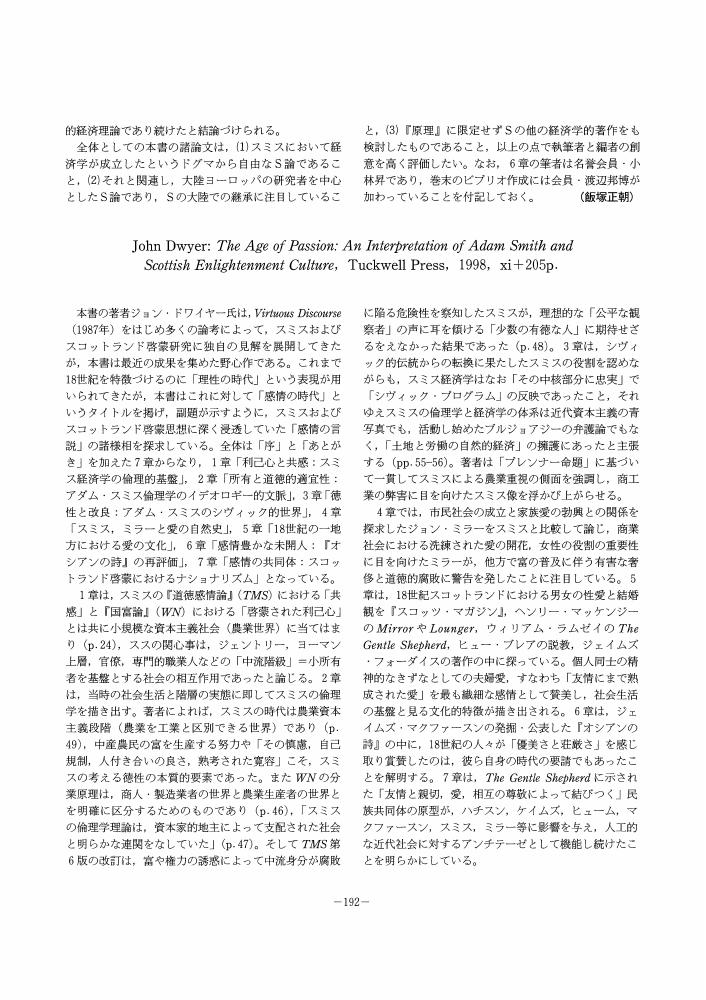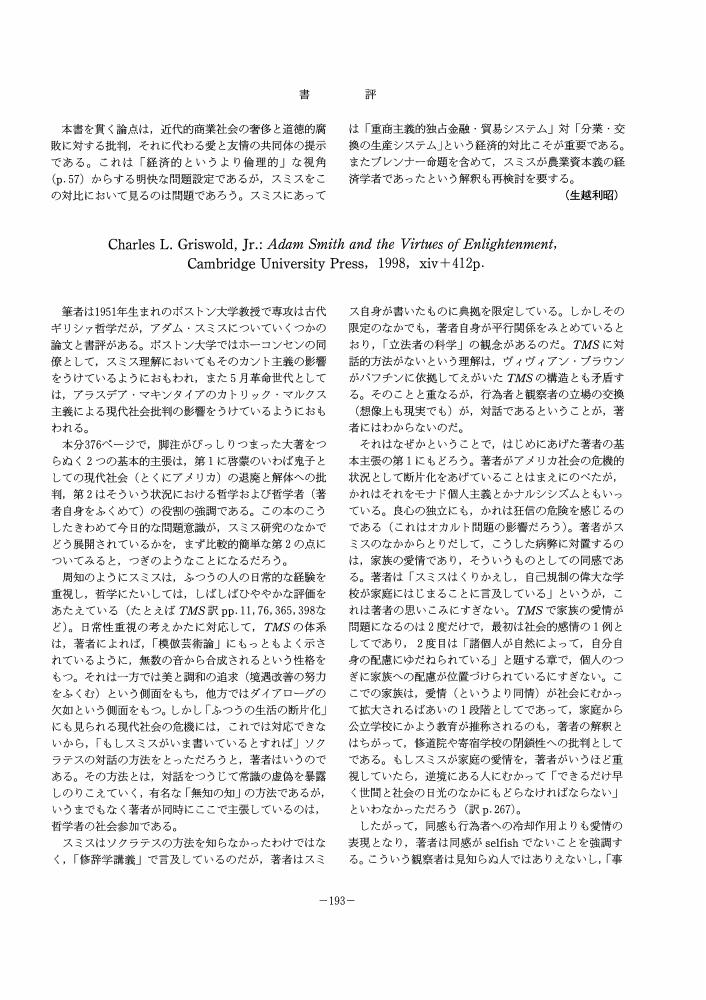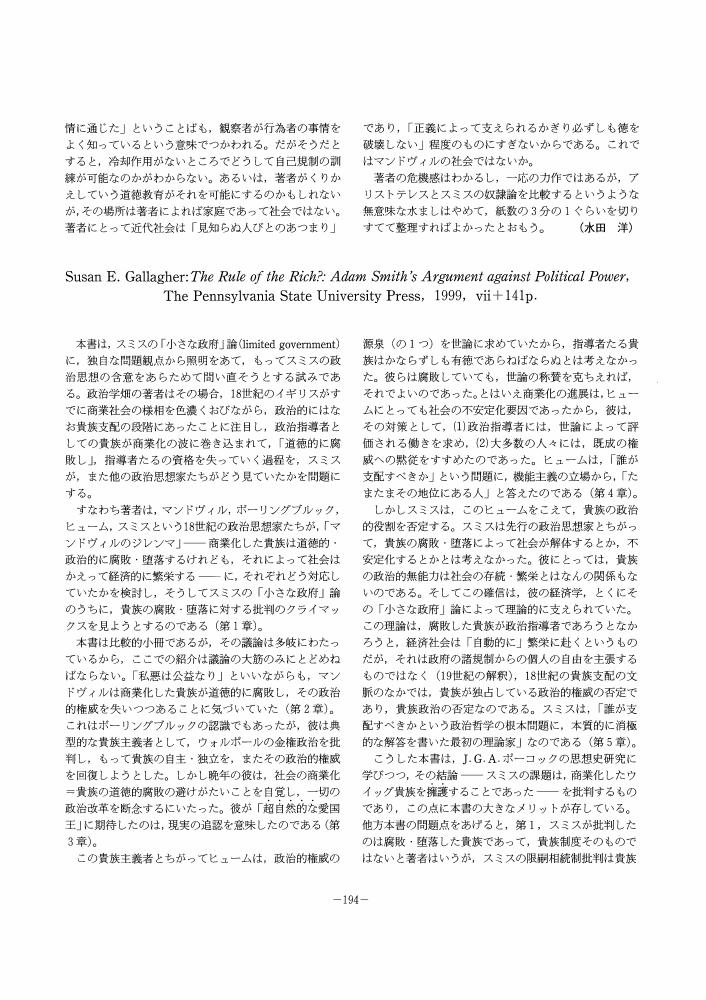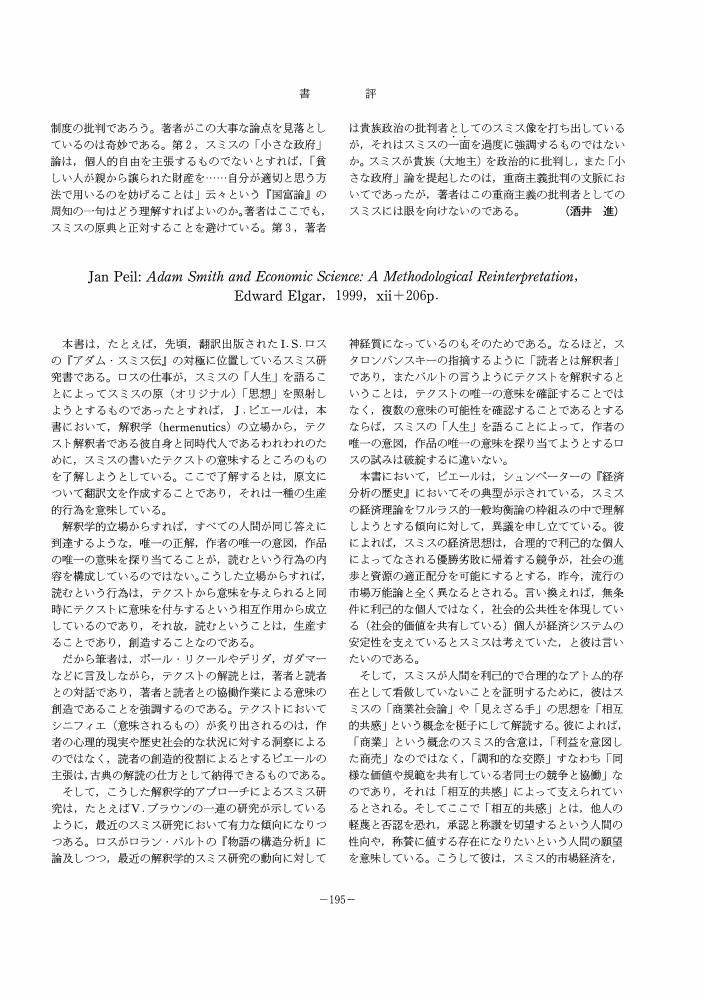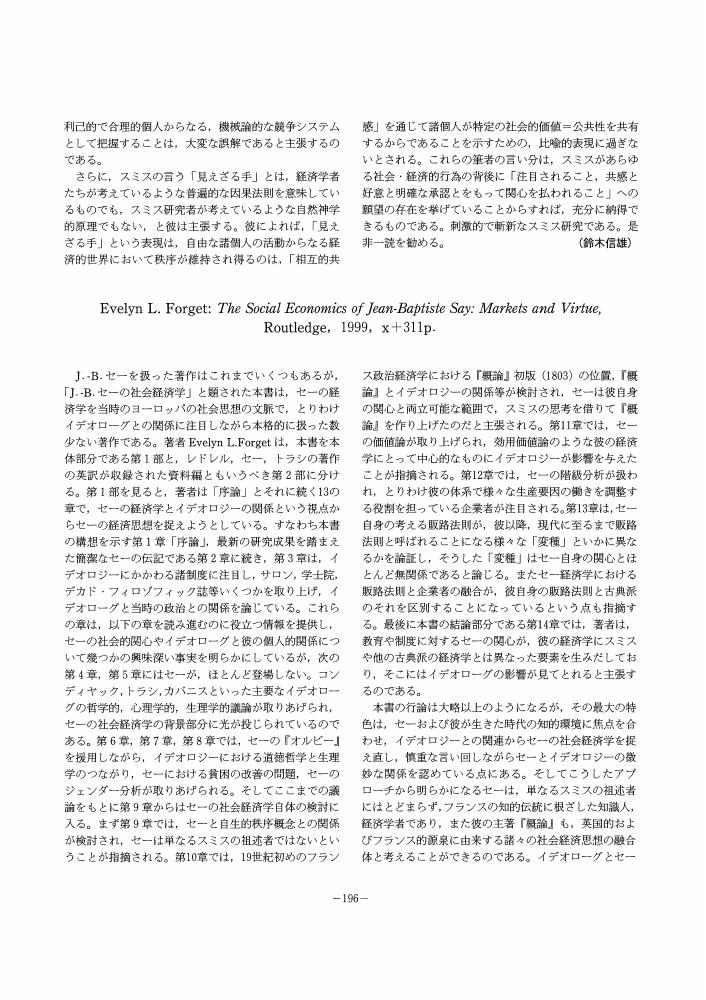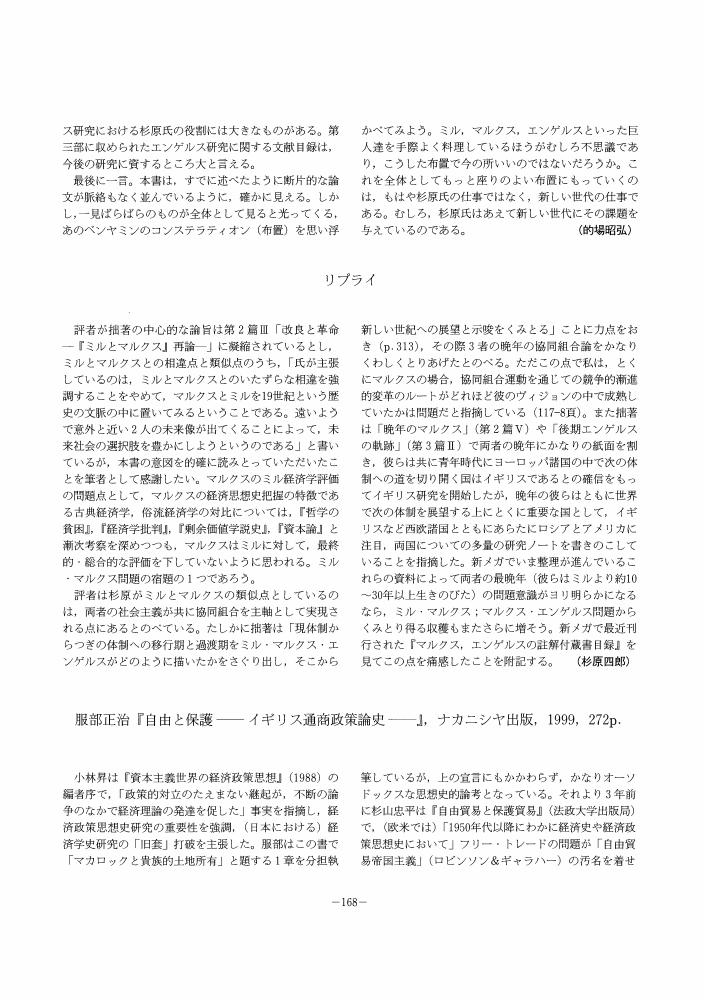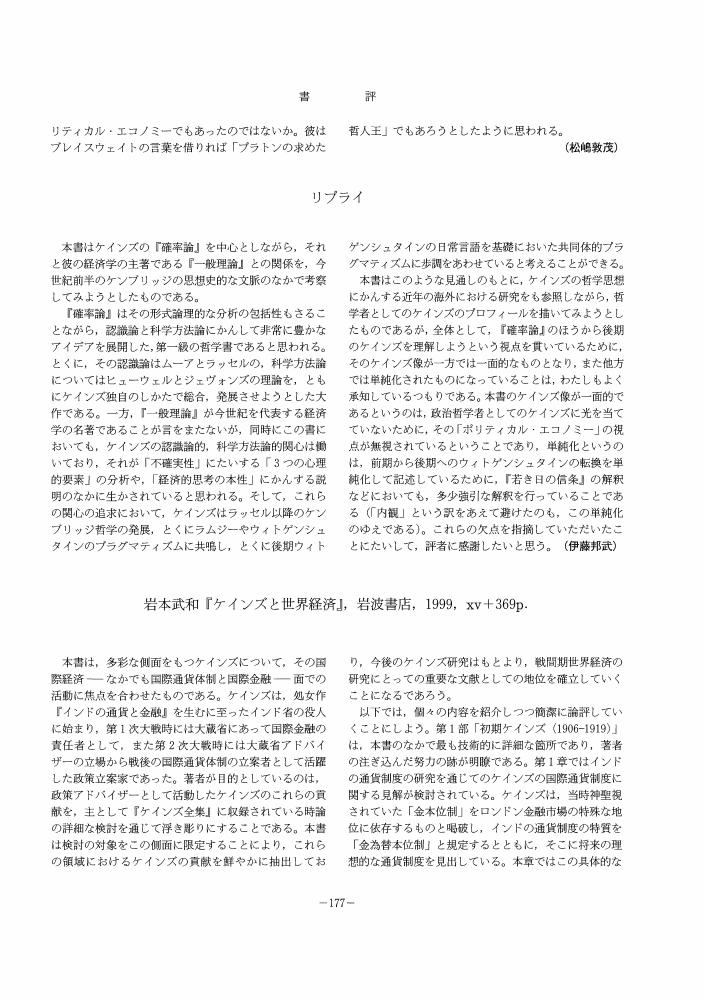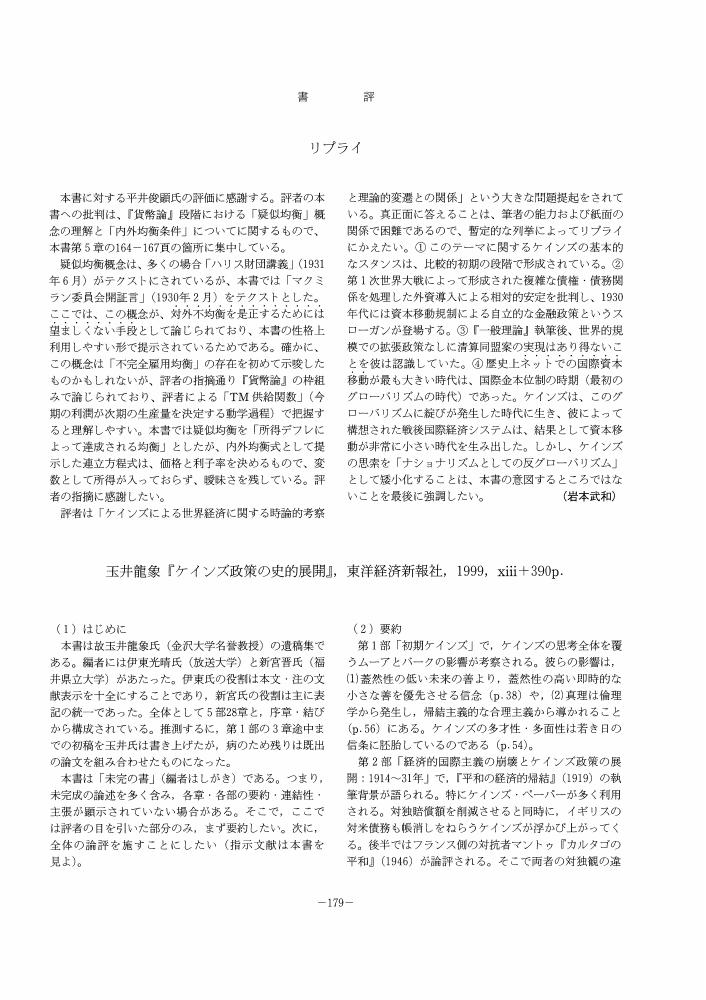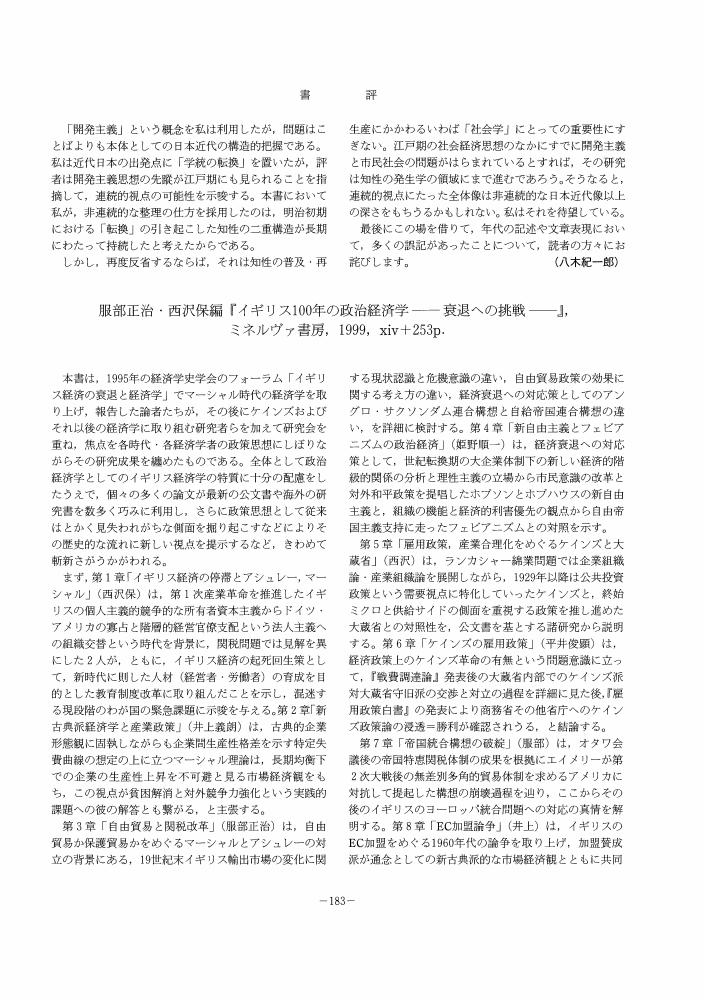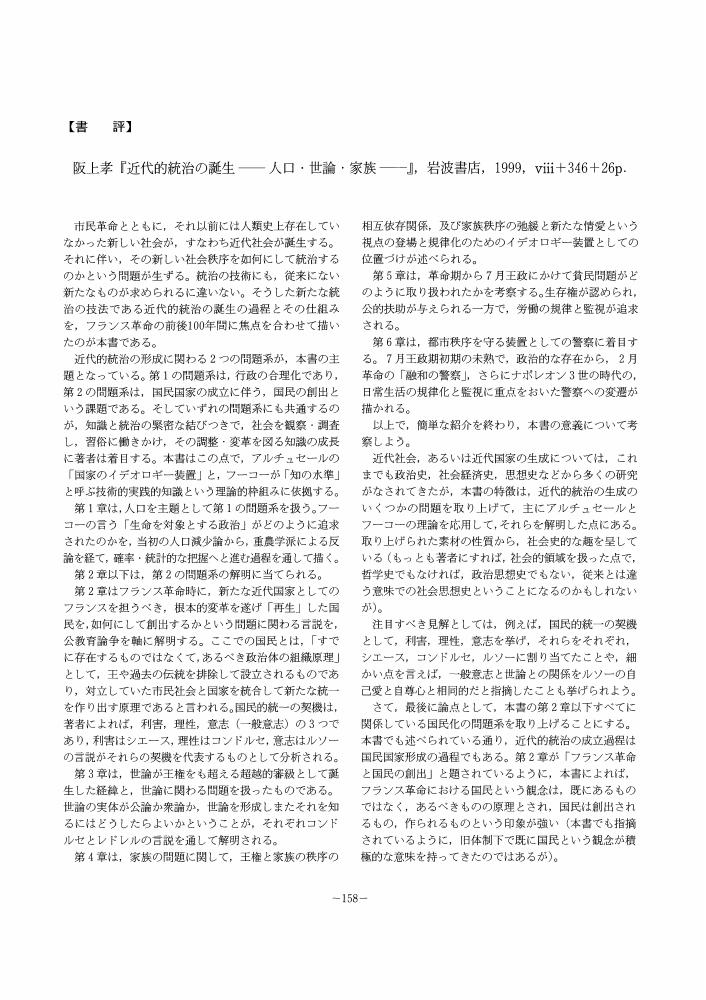- 著者
- 生越 利昭
- 出版者
- The Japanese Society for the History of Economic Thought
- 雑誌
- 経済学史学会年報 (ISSN:04534786)
- 巻号頁・発行日
- vol.38, no.38, pp.192-193, 2000 (Released:2010-08-05)
- 著者
- 水田 洋
- 出版者
- The Japanese Society for the History of Economic Thought
- 雑誌
- 経済学史学会年報 (ISSN:04534786)
- 巻号頁・発行日
- vol.38, no.38, pp.193-194, 2000 (Released:2010-08-05)
- 著者
- 酒井 進
- 出版者
- The Japanese Society for the History of Economic Thought
- 雑誌
- 経済学史学会年報 (ISSN:04534786)
- 巻号頁・発行日
- vol.38, no.38, pp.194-195, 2000 (Released:2010-08-05)
- 著者
- 鈴木 信雄
- 出版者
- The Japanese Society for the History of Economic Thought
- 雑誌
- 経済学史学会年報 (ISSN:04534786)
- 巻号頁・発行日
- vol.38, no.38, pp.195-196, 2000 (Released:2010-08-05)
- 著者
- 喜多 見洋
- 出版者
- The Japanese Society for the History of Economic Thought
- 雑誌
- 経済学史学会年報 (ISSN:04534786)
- 巻号頁・発行日
- vol.38, no.38, pp.196-197, 2000 (Released:2010-08-05)
1 0 0 0 OA 杉原四郎『ミル・マルクス・エンゲルス』, 世界書院, 1999, v+317+10p.
- 出版者
- 経済学史学会
- 雑誌
- 経済学史学会年報 (ISSN:04534786)
- 巻号頁・発行日
- vol.38, no.38, pp.166-168, 2000 (Released:2010-08-05)
- 著者
- 橋本 昭一
- 出版者
- 経済学史学会
- 雑誌
- 経済学史学会年報 (ISSN:04534786)
- 巻号頁・発行日
- vol.38, no.38, pp.168-170, 2000 (Released:2010-08-05)
- 出版者
- 経済学史学会
- 雑誌
- 経済学史学会年報 (ISSN:04534786)
- 巻号頁・発行日
- vol.38, no.38, pp.170-172, 2000 (Released:2010-08-05)
1 0 0 0 OA 福岡正夫『歴史のなかの経済学』, 創文社, 1999, ix+477p.
- 出版者
- 経済学史学会
- 雑誌
- 経済学史学会年報 (ISSN:04534786)
- 巻号頁・発行日
- vol.38, no.38, pp.173-175, 2000 (Released:2010-08-05)
1 0 0 0 OA 伊藤邦武『ケインズの哲学』, 岩波書店, 1999, vii+242p.
- 出版者
- 経済学史学会
- 雑誌
- 経済学史学会年報 (ISSN:04534786)
- 巻号頁・発行日
- vol.38, no.38, pp.175-177, 2000 (Released:2010-08-05)
1 0 0 0 OA 岩本武和『ケインズと世界経済』, 岩波書店, 1999, xv+369p.
- 出版者
- 経済学史学会
- 雑誌
- 経済学史学会年報 (ISSN:04534786)
- 巻号頁・発行日
- vol.38, no.38, pp.177-179, 2000 (Released:2010-08-05)
1 0 0 0 OA 玉井龍象『ケインズ政策の史的展開』, 東洋経済新報社, 1999, xiii+390p.
- 著者
- 小峯 敦
- 出版者
- 経済学史学会
- 雑誌
- 経済学史学会年報 (ISSN:04534786)
- 巻号頁・発行日
- vol.38, no.38, pp.179-180, 2000 (Released:2010-08-05)
1 0 0 0 OA 八木紀一郎『近代日本の社会経済学』, 筑摩書房, 1999, x+245+viip.
- 出版者
- 経済学史学会
- 雑誌
- 経済学史学会年報 (ISSN:04534786)
- 巻号頁・発行日
- vol.38, no.38, pp.181-183, 2000 (Released:2010-08-05)
- 著者
- 浅野 栄一
- 出版者
- 経済学史学会
- 雑誌
- 経済学史学会年報 (ISSN:04534786)
- 巻号頁・発行日
- vol.38, no.38, pp.183-184, 2000 (Released:2010-08-05)
1 0 0 0 OA ヒュームにおける「奢修」と文明社会
- 著者
- 壽里 竜
- 出版者
- The Japanese Society for the History of Economic Thought
- 雑誌
- 経済学史学会年報 (ISSN:04534786)
- 巻号頁・発行日
- vol.38, no.38, pp.98-110, 2000 (Released:2010-08-05)
David Hume's theory of luxury has been studied chiefly from the viewpoint of the history of economic theory, but its real importance can be understood only when it is placed in a wider historical context of morals and politics. Hume first attempts to clarify the interdependent relationships between specific moral characters and particular constitutional arrangements as demonstrated by the affinity between the virtue of industry and free government. He claims that the virtue of industry begins to degrade into corrupt forms of avarice and egoism when it overrides its proper limit of moderation. Hume's well-known attack upon the traditional notion of luxury and his vigorous defense of its modern notion as the refinement of arts entail another so-far neglected element of his skeptical attitude toward unregulated vicious forms of luxury. Hume employs the notion of “honour”, traditionally taken as one with the classical virtue of martial spirit, for strengthening those morally acceptable exertions of industry and for guaranteeing its socially beneficial consequences. This does not necessarily indicate a more pessimistic interpretation of Hume's theory of luxury than that so far accepted. Rather it argues in favor of Hume's overall strategy for the defense of modern civilization as the fundamental attack against both the classical and the modern extreme notions of luxury.
1 0 0 0 OA ジェイムズ・ステユアートの利子概念
- 著者
- 古谷 豊
- 出版者
- The Japanese Society for the History of Economic Thought
- 雑誌
- 経済学史学会年報 (ISSN:04534786)
- 巻号頁・発行日
- vol.38, no.38, pp.111-122, 2000 (Released:2010-08-05)
- 参考文献数
- 13
Over the last few years a considerable number of studies have been made on various problems regarding James Steuart's theory of interest. What seems to be lacking, however, is a study on the very nature of the “interest” concept in Steuart's theory.S. Okuda is among those who note that analysis on this subject is necessary for investigating other problems regarding Steuart's theory of interest. Steuart describes that a landed man, who received paper (money) for a land security has to pay interest to the bank because the paper “circulates like money, ” but the land does not. From this description, Okuda concluded that Steuart understood interest as the price for receiving the liquidity of money. And this idea is now widely accepted.There are some objections that can be raised against this interpretation. This conclusion is true for the landlords, but not for the industrious class, or the state. Here one gets a glimpse of the secret background of Steuart's “interest” concept. In Steuart's theory of political economy, the theory of interest is the base of the theory of credit, and Steuart argues the “interest” concept according to the structure of his theory of credit.
1 0 0 0 OA リカードの労働価値理論の論理構成
- 著者
- 福田 進治
- 出版者
- The Japanese Society for the History of Economic Thought
- 雑誌
- 経済学史学会年報 (ISSN:04534786)
- 巻号頁・発行日
- vol.38, no.38, pp.123-133, 2000 (Released:2010-08-05)
- 参考文献数
- 23
A task of this paper is to make clear a logical construction of David Ricardo's Pure Labour Theory of Value (LTV) which is formed under the condition that the capital structures are identical among production sectors.For this task, defining the basic formulation of the LTV, this paper first states that the theory is derived from a formulation that is defined by arranging Ricardo's arguments of value and price, and, second, the paper claims that the theory is formed by modeling a process of formation of a uniform rate of profit through capital transfers between production sectors. The paper makes clear that the more essential assumptions for the formation of the LTV are the formation of a uniform rate of profit among production sectors and the definition of the technical conditions of production in the sector producing money-good.The logic of the LTV establishes the principle that profits are determined as Surplus out of products, that in the logic of the LTV a level of general or uniform rate of profit is determined by the conditions of production in the sector producing money-good as a main factor, and that the LTV is formed on certain assumptions whether demand and supply are equal or not in each production sector. In these implications the LTV is one basic style of real cost theory for the determination of prices.
1 0 0 0 OA ケインズの金融的動機
- 著者
- 内藤 敦之
- 出版者
- The Japanese Society for the History of Economic Thought
- 雑誌
- 経済学史学会年報 (ISSN:04534786)
- 巻号頁・発行日
- vol.38, no.38, pp.146-157, 2000 (Released:2010-08-05)
- 参考文献数
- 28
After publishing the General Theory, Keynes introduced a fourth motive of holding money called the ‘finance motive.’ There are not many studies on Keynes's articles after 1937 by historians of economic thought, but there are by comparison many papers by Post Keynesians. First, in this paper I investigate the process of formation of the finance motive according to Ohlin's critiques. Second, I explore the controversy between Keynes and Robertson. Third, I consider the relationship of Post Keynesian interpretation to the controversy between Keynes and Robertson, and last, I examine the position of the finance motive.The conclusions of this paper are: First, the finance motive is introduced by responding to Ohlin's critiques and is considered to be a concession to Ohlin, but the core of liquidity preference theory is not revised. Second, Robertson's critique shows that the banking system can be illiquid, but the reason for Keynes's neglect of Robertson's critique is that Keynes implicitly considered the case of endogenous money supply. Third, the view of regarding the finance motive as a fourth motive is more close to Keynes's aim than is the view of connecting the finance motive and the transactions motive.
- 著者
- 森岡 邦泰
- 出版者
- 経済学史学会
- 雑誌
- 経済学史学会年報 (ISSN:04534786)
- 巻号頁・発行日
- vol.38, no.38, pp.158-159, 2000 (Released:2010-08-05)
- 出版者
- 経済学史学会
- 雑誌
- 経済学史学会年報 (ISSN:04534786)
- 巻号頁・発行日
- vol.38, no.38, pp.159-161, 2000 (Released:2010-08-05)
